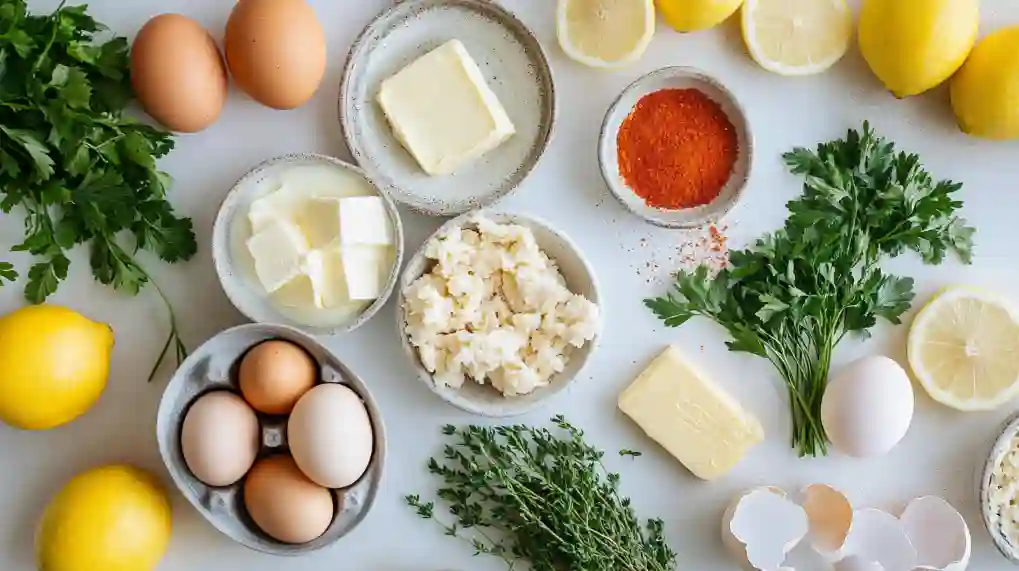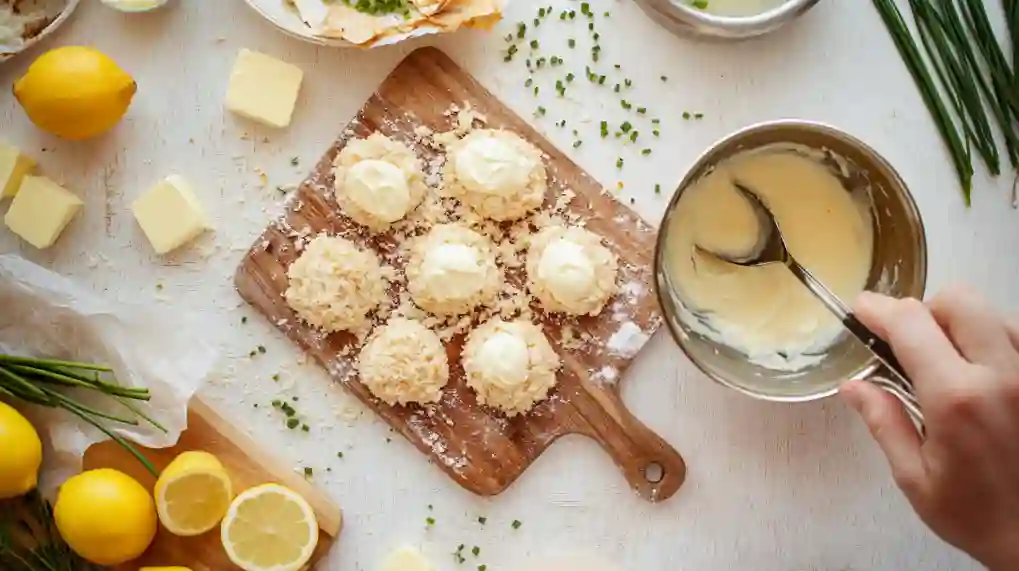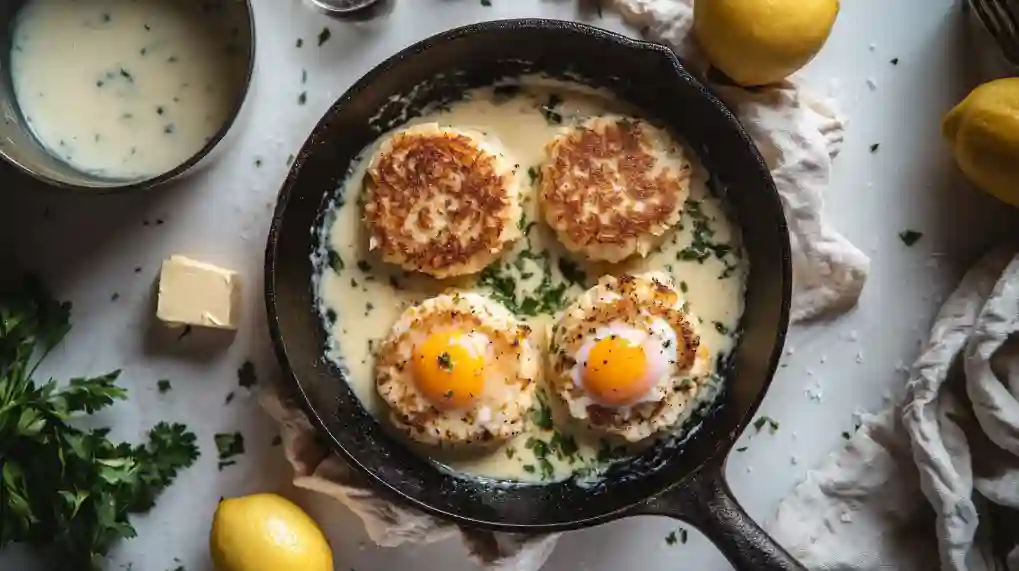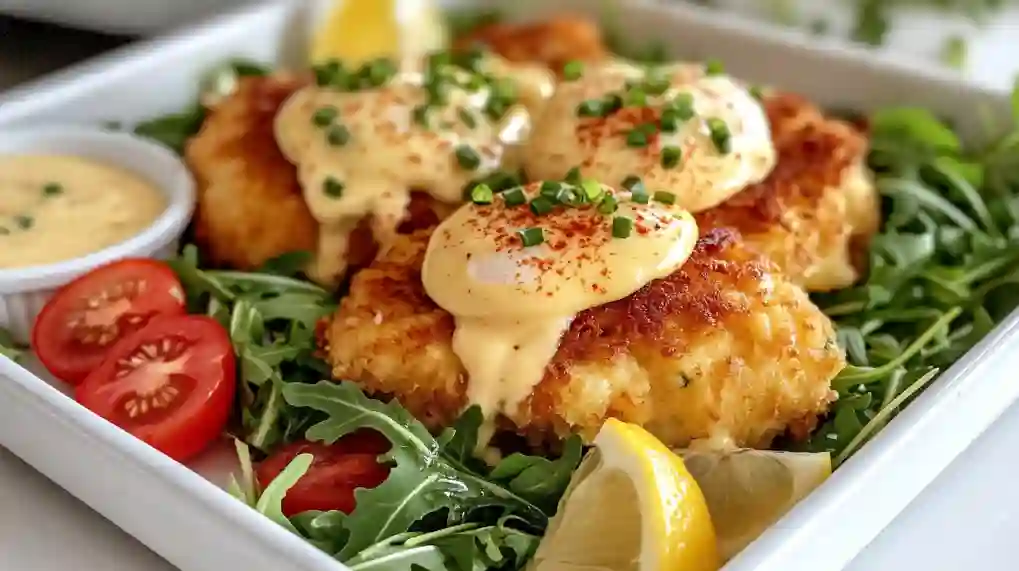A Luxurious Twist on a Classic Favorite
magine cutting into a golden, crispy crab cake, stacked on a warm, toasted English muffin. As your fork slices through, a perfectly poached egg releases its silky, golden yolk, mingling with a velvety drizzle of creamy hollandaise sauce. Each bite is a harmony of crisp textures, rich flavors, and buttery, ocean-kissed decadence — a true feast for the senses.
Eggs Benedict has long been a symbol of brunch indulgence, believed to have originated in New York City’s luxury dining scene in the late 1800s. Traditionally featuring Canadian bacon, it has since inspired countless delicious variations. Adding a succulent crab cake to this classic brings a luxurious coastal twist, infusing it with the sweet, tender flavors of the sea.
I first encountered Crab Cake Eggs Benedict during a seaside vacation on the Chesapeake Bay. After a morning stroll along the docks, I stumbled into a charming café that served this incredible dish. One bite, and I was hooked — the richness of the crab, the softness of the egg, and the bright, lemony hollandaise left a lasting impression.
This twist on the classic is irresistible: bold, vibrant flavors and a melt-in-your-mouth experience that feels both indulgent and refreshingly light. Plus, crab meat offers healthy perks — it’s packed with lean protein, omega-3 fatty acids, and is naturally low in saturated fat.
Table of Contents
Ingredients for the Perfect Crab Cake Eggs Benedict

Every luxurious bite of Crab Cake Eggs Benedict starts with choosing the right ingredients. Here’s everything you’ll need to recreate this seaside brunch masterpiece at home:
For the Crab Cakes:
- 8 oz fresh lump crab meat – Look for refrigerated, high-quality options if fresh isn’t available.
- 1/4 cup Panko breadcrumbs – Adds that light, crisp texture.
- 2 tablespoons mayonnaise – Or swap with Greek yogurt for a lighter touch.
- 1 teaspoon Dijon mustard – For a hint of savory sharpness.
- 1/2 teaspoon Old Bay seasoning – Essential for classic coastal flavor.
- 1 tablespoon lemon juice – Brightens the entire dish.
- 1 tablespoon fresh parsley, chopped – Freshness in every bite.
- 1 egg, lightly beaten – To bind it all together.
For the Benedict Assembly:
- 2 English muffins, split and toasted – Crisp and warm to anchor the layers.
- 4 fresh eggs – The stars for poaching perfection.
- 1 tablespoon vinegar – Helps poached eggs hold their shape.
For the Hollandaise Sauce:
- 3 egg yolks – The foundation of rich, creamy sauce.
- 1/2 cup melted butter – For that signature indulgence.
- 1 tablespoon lemon juice – Adds a zesty lift.
- Pinch of cayenne pepper – Optional, but it adds a subtle kick.
Substitutions & Smart Tips:
- Gluten-Free Option: Swap regular Panko for gluten-free breadcrumbs without losing that delicious crunch.
- Healthier Crab Cakes: Use Greek yogurt instead of mayonnaise for a lighter, protein-packed version.
- Shortcut Hollandaise: Short on time? High-quality store-bought hollandaise can be a lifesaver — just warm gently before serving.
- Crab Meat Selection: Fresh is best, but if using canned crab, opt for premium brands labeled “lump” or “jumbo lump” — and always drain and gently pat dry for the freshest taste.
Choosing quality ingredients is the secret to turning a simple brunch into an unforgettable feast!
Step-by-Step Instructions: Building the Ultimate Crab Cake Eggs Benedict
Mastering Crab Cake Eggs Benedict at home is all about timing, texture, and a little bit of love. Follow these steps for a brunch dish that’s worthy of a seaside café.
Step 1: Prepare the Crab Cakes

In a large bowl, gently fold together the crab meat, Panko breadcrumbs, mayonnaise (or Greek yogurt), Dijon mustard, Old Bay seasoning, lemon juice, parsley, and the lightly beaten egg. Take care not to overmix — you want to preserve those luscious lumps of crab for a tender, luxurious bite.
Form the mixture into small, uniform patties, roughly the size of your English muffin halves. Place them on a baking sheet lined with parchment paper and chill in the refrigerator for at least 30 minutes. This crucial step helps the cakes firm up, making them easier to fry.
When ready to cook, heat a thin layer of oil in a skillet over medium heat. Pan-fry the crab cakes for 3–4 minutes per side, until they develop a deep golden crust. Set aside on a paper towel to drain any excess oil.
Step 2: Make the Hollandaise
While the crab cakes chill or cook, begin your hollandaise. In a heatproof bowl set over a pot of gently simmering water (a makeshift double boiler), whisk together the egg yolks and lemon juice until they thicken slightly and lighten in color.
Slowly drizzle in the melted butter, whisking continuously to emulsify the sauce into a silky, creamy consistency. Season with a pinch of cayenne pepper and a little salt to taste. Keep the sauce warm by leaving it over the warm water (off the heat) until ready to serve.
Shortcut: For an easier method, you can make hollandaise in a blender — blend yolks and lemon, then gradually add hot butter until thick and glossy.
Step 3: Poach the Eggs
Bring a pot of water to a gentle simmer and add a tablespoon of vinegar. Stir the water to create a gentle whirlpool; this helps the egg whites wrap neatly around the yolks. Carefully crack and slide each egg into the center of the vortex.
Poach for about 3–4 minutes, until the whites are fully set but the yolks remain runny and soft. Remove each egg with a slotted spoon and let them briefly drain on a paper towel.
Tip: Fresh eggs work best for poaching because their whites are firmer and hold shape better.
Step 4: Toast the Muffins
Meanwhile, toast your English muffins until they are crisp and golden brown. A sturdy base is essential to hold all the delicious layers without becoming soggy.
Step 5: Assemble
Now, the magic moment:
Place a crispy crab cake on each toasted muffin half. Top each crab cake with a perfectly poached egg, and then generously drizzle the warm, creamy hollandaise over the top.
Finish with a sprinkle of freshly chopped chives, a pinch of paprika, or a few delicate microgreens for a beautiful final touch. Serve immediately and savor every luxurious bite!
Tips, Variations, and Creative Twists for Crab Cake Eggs Benedict
Once you’ve mastered the classic, why not make this luxurious brunch dish your own? Here are some easy ways to lighten it up, amp up the flavor, or add a creative spin — plus a few simple presentation tips to truly wow your guests.
Healthier Versions
- Bake Instead of Fry: For a lighter version of the crab cakes, bake them at 400°F (200°C) for about 12–15 minutes, flipping halfway through. They’ll still turn golden and delicious without the extra oil.
- Yogurt-Based Hollandaise: Swap traditional butter with a Greek yogurt base for a tangy, lower-fat hollandaise. It’s creamy, bright, and refreshingly light — perfect for a guilt-free indulgence.
Flavor Boosters
- Spice It Up: Add a few dashes of your favorite hot sauce to the hollandaise for a subtle, fiery kick that cuts through the richness beautifully.
- Briny Touch: Sprinkle a few capers over the finished dish for a pop of briny, salty flavor that pairs beautifully with the sweet crab meat.
Creative Variations
- Low-Carb Option: Instead of English muffins, layer your crab cakes and eggs over creamy avocado slices for a fresh, low-carb alternative.
- Florentine Twist: Add a bed of sautéed spinach between the muffin and crab cake for a “Crab Cake Eggs Florentine” — boosting both flavor and nutrition.

Presentation Tips
- Think Tall: Stack your layers neatly and aim for height to create an elegant, restaurant-style look.
- Garnish with Style: Finish with a lemon wedge on the side and scatter colorful microgreens on the plate for a fresh, vibrant presentation that makes every plate Instagram-worthy.
Nutritional Information: A Deliciously Balanced Indulgence
Crab Cake Eggs Benedict isn’t just a feast for your taste buds — it offers some impressive nutritional benefits too. Here’s a breakdown of what you’re getting in every satisfying serving:
Approximate Per Serving:
- Calories: 480–550
- Protein: 32g
- Fat: 30–35g
- Carbohydrates: 20–30g
Nutritional Highlights
This decadent brunch dish delivers a strong high-protein, low-carb balance, making it perfect for those who want indulgence without overdoing it. The crab meat is a nutritional superstar — naturally low in fat but rich in omega-3 fatty acids, which support heart health and reduce inflammation.
Crab is also packed with essential minerals like selenium, which boosts your immune system, and vitamin B12, vital for energy production and brain function. Combined with free-range eggs and fresh ingredients, this dish offers a hearty, nutrient-dense start to your day.
Lighten It Up:
If you’re looking to make this brunch a bit lighter without sacrificing flavor:
- Reduce the butter in the hollandaise sauce, or opt for a yogurt-based version for a creamy texture with less saturated fat.
- Switch to whole wheat English muffins to add fiber and complex carbs, keeping you full and energized longer.
With a few simple tweaks, you can enjoy all the rich flavors and textures while keeping things a bit lighter — because delicious can also be nutritious!
Common Mistakes & Easy Fixes: Brunch Success Made Simple
Even seasoned cooks can hit a few snags when making Crab Cake Eggs Benedict. Here’s how to troubleshoot the most common issues — and save your beautiful brunch without stress.
Broken Hollandaise
Hollandaise sauce can be a little fussy. If it breaks (separates into oily and watery layers), don’t panic. Quickly whisk in a spoonful of hot water to bring it back together. If that doesn’t work, start fresh with a gentle heat and constant whisking. Patience is key for that luscious, creamy finish.
Falling Apart Crab Cakes
If your crab cakes are crumbling in the pan, chances are the mixture wasn’t cold enough. Always chill your patties for at least 30 minutes before cooking, and handle them gently when flipping. A delicate touch keeps the cakes intact and beautifully golden.
Overcooked Eggs
Perfect poached eggs should have tender whites and oozy yolks. Keep a close eye and remove eggs after 3–4 minutes. They will continue to cook slightly from residual heat, so swift action is essential for that dreamy, runny center.
Soggy English Muffins
Nobody likes a soggy base. Toast your English muffins thoroughly until golden and crisp. Also, assemble just before serving to keep the texture spot-on — especially if you’re hosting brunch for a crowd.
Too Salty
With Old Bay seasoning, butter, and crab naturally containing salt, it’s easy to go overboard. Taste your crab mixture and hollandaise separately before adding extra salt. Season thoughtfully to let the fresh flavors shine without overwhelming your palate.
FAQs: Your Crab Cake Eggs Benedict Questions Answered
Q1: Can I make the crab cakes ahead of time?
A: Absolutely! You can shape the crab cakes and refrigerate them for up to 24 hours before cooking. Chilling not only saves time but also helps the patties firm up beautifully for easier frying.
Q2: Is there an easy way to make hollandaise sauce?
A: Yes — the blender method is a fantastic shortcut! Blend the egg yolks and lemon juice first, then slowly stream in hot melted butter while blending. It’s quick, reliable, and creates a luscious, creamy hollandaise with minimal effort.

Q3: What can I use instead of English muffins?
A: Feel free to get creative! Brioche buns add a touch of sweetness, gluten-free muffins are perfect for dietary needs, and for a low-carb twist, roasted sweet potato rounds make a delicious, hearty alternative.
Q4: How do I store leftovers?
A: Keep components separate for best results. Store the crab cakes and hollandaise sauce in airtight containers in the fridge for up to 2 days. Reheat crab cakes gently in a skillet or oven, and warm hollandaise slowly over low heat or using a double boiler to preserve its creamy texture.
Q5: Can I use canned crab meat?
A: While fresh or pasteurized crab is ideal for the best flavor and texture, drained canned crab can work in a pinch. Just be sure to choose high-quality “lump” crab meat and handle it gently when mixing to maintain a nice texture.
Conclusion: Bring Coastal Elegance to Your Brunch Table
Crab Cake Eggs Benedict truly captures the spirit of a perfect elevated brunch — indulgent, satisfying, and brimming with coastal charm. With its golden, buttery crab cakes, luscious poached eggs, and rich, silky hollandaise, this dish transforms an ordinary morning into a restaurant-worthy experience.
The best part? With a little preparation and a few simple techniques, you can easily wow your family and friends right from your own kitchen. It’s the kind of dish that feels luxurious yet totally achievable, whether you’re celebrating a special occasion or simply treating yourself this weekend.
Ready to impress at your next brunch gathering? Give this Crab Cake Eggs Benedict a try — then make it your own with fun twists and creative toppings! When you do, be sure to share your creations and tag us on social media or drop your personal variations in the comments below — we love seeing your delicious takes!
Looking for even more brunch inspiration? Don’t miss some of our other favorites on the blog, like:
- Classic Eggs Benedict
- Avocado Toast with Smoked Salmon
- Crab and Avocado Salad
Happy brunching! 🌊🍳✨


4 thoughts on “Delightful Crab Cake Eggs Benedict”
Comments are closed.